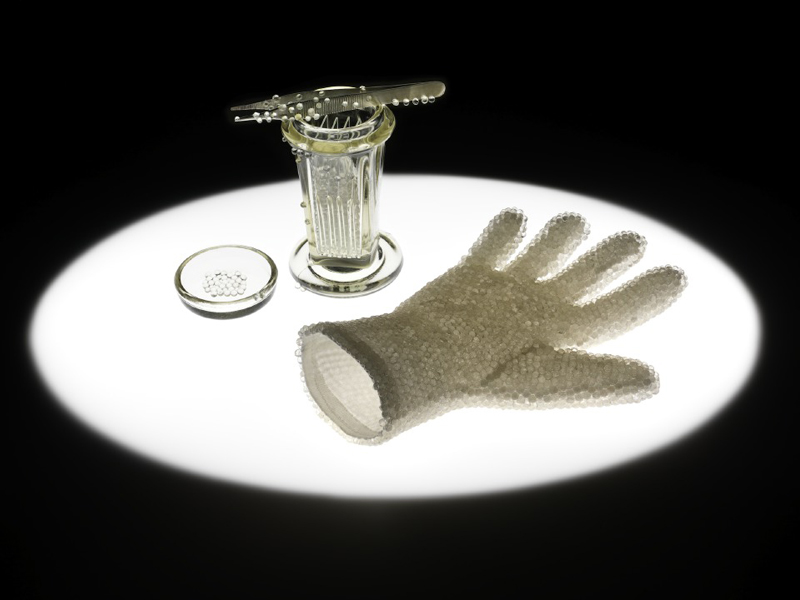
Jess Dare, Catherine Truman, and Sue Lorraine, The Theatre of Detail
July 10–25, 2015
Airspace Projects Gallery, Sydney, Australia
Thirtieth birthdays are always important. Everyone suffers or celebrates, according to their fashion. But translate people years into jewelry years—30 years of running a continuous, independent, collectively managed workshop—now that’s an achievement! In 2015 Australia’s Gray Street Workshop (GSW), based in the southern city of Adelaide, is celebrating this persistence, survival on its own terms, and, even more, optimism for the future.
Gray Street Workshop is a living, breathing jewelry hub that attracts energy and multiplies it. Thoughtfully, purposefully. Working together in a shared space, the partners of GSW prize the daily informal exchange of ideas, skills, and support. This has been achieved with only six partners: since 1985, Anne Brennan (until 1990), Sue Lorraine, and Catherine Truman; Leslie Matthews (1986–2010); Julie Blyfield (1987–2010); and Jess Dare (since 2010). Oh, plus around 100 past and present tenants over the 30 years, at all stages of their careers. (See http://graystreetworkshop.com.) Here is continuity, but also, importantly, community.
The Workshop formed in 1985 through the affinity of the partners’ interests, as jewelers, and as feminists, and the principle of affinity still rules today. Jess Dare, GSW’s most recent partner, tells me she started in 2007 with a week’s student work experience, and immediately applied for a bench in the Workshop’s next regular call-out. In effect, Dare found Gray Street and never left: When Truman and Lorraine were seeking a third partner, she joined the business. Support and mentoring is informal and ongoing—there are no formal crit sessions—but this is a regular business concern. All tenants sign contracts, and the partners are financially responsible for the Workshop.
The partners pursue independent careers, but they exhibit together from time to time, including, since 2011, in their own tiny successful retail gallery. And each significant Workshop anniversary is celebrated with a special project. The current celebrations are The Theatre of Detail, a touring exhibition by Jess Dare, Sue Lorraine, and Catherine Truman; a year-long website featuring 12 jewelers from Australia and New Zealand associated with Gray Street over the years; and a curated season of films about bodies and jewelry during the Australian summer. This 30th birthday is especially exciting: It demonstrates the Workshop’s vitality and currency rather than commemorating past achievements.
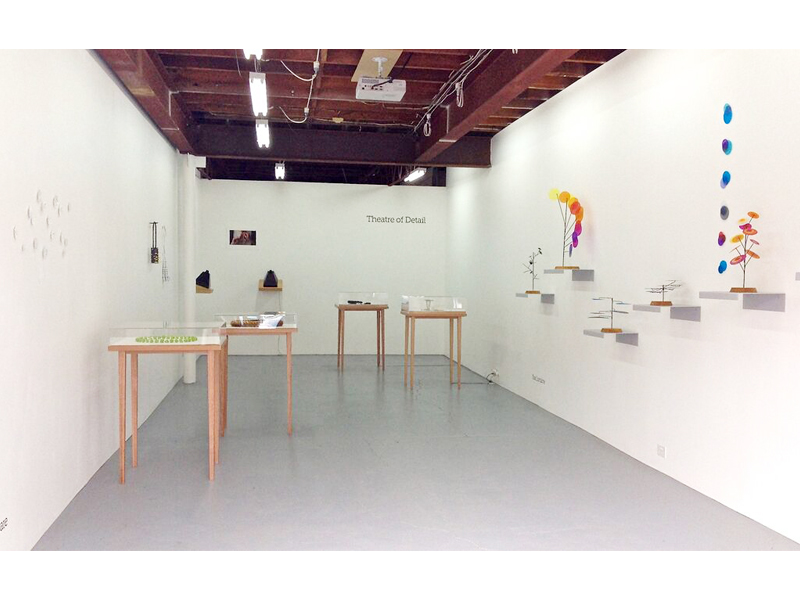
The Theatre of Detail reveals remarkable independence of vision allied with a strong collective ethos. The exhibition title is, of course, a convenient cover-all, but it does refer to the intensity, and the intellectual and creative ambition, of GSW’s jewelers. Detail is prized, in different ways, by all three: acuity, accuracy, focus. Part of this is a concentrated conceptual approach to making: Ideas driving the work are privileged, the materials and methods are chosen to substantiate core concepts. Ever since its early days in the mid-1980s, with feminist works exploring women’s bodies and experiences, Workshop partners have emphasized exploring thematically coherent bodies of exhibition work, which fed into parallel streams of production works and commissioned (often public) artworks. This ideas-driven philosophy of making often leads to unexpected outcomes. In this exhibition, for example, although the works were either inspired by or related to the body and wearing, many were not wearable.
Let me take the newest (youngest) partner first. Jess Dare works—as some have told her—“eccentrically,” with the now-unfashionable medium of lamp-worked glass, as well as metal. Speaking at The Theatre of Detail, she recalled Truman’s advice some years ago to stick with what she loved: one Gray Street hallmark is an open attitude to materials. Hugely talented, very resilient, Dare has exhibited fine bodies of work in recent years that circle around flowers and their ephemerality. The new work came out of a three-month residency in Thailand during 2014, undertaken through Australia’s long-running Asialink program. Dare learned how to make traditional phuang malai, or flower garlands, used as offerings, decoration, and gifts, and also studied bronze casting and other techniques with Thailand’s exceptional artisans.
![[left] Jess Dare, Offerings: Meditation Malai, 2015, flameworked glass, dimensions variable, photo: Grant Hancock [right] Jess Dare, Offerings: Elementary Phuang Malai, 2015, necklace, powder-coated brass, copper, cotton thread, 610 x 380 x 40 mm, photo: Grant Hancock [left] Jess Dare, Offerings: Meditation Malai, 2015, flameworked glass, dimensions variable, photo: Grant Hancock [right] Jess Dare, Offerings: Elementary Phuang Malai, 2015, necklace, powder-coated brass, copper, cotton thread, 610 x 380 x 40 mm, photo: Grant Hancock](/sites/default/files/rev_jewington_3_4_600x800px.jpg)
This energetic body of work was produced immediately following Dare’s return to Australia. As she said, she barely had time to process the experience, and several works are quite close to Thai prototypes. Offerings: Presentation Garland, made from numerous sheets of cut brass, recapitulates the beautiful twisting form of one type of traditional garland, though Offerings: Meditation Malai, in green opaque glass, remains unstrung, suspended, as it were, out of use. Offerings: Happy Birthday Dear King is formed of metal flowers cast from birthday candleholders, its yellow candles the color reserved in Thailand for royalty. My favorite is Offerings: Fading Yeb Bab, evoking decorative mandalas used for Buddhist decoration. Made from white powder-coated brass, with stitched flame-worked petals, and in a variety of forms and shapes, the flowers seem to fade and die. There is a nice mix of confidence and simplicity, and, paradoxically, the crisp handling of the materials suggests the pathos of fading beauty.
![[left] Exhibition view (detail), Theatre of Detail, 2015, foreground work from the series Models of Light by Sue Lorraine, Airspace Projects Gallery, Sydney, photo: Catherine Truman [right] Sue Lorraine, Models of Light: Sun Burst Model, 2015, heat-colored steel, sterling silver, Tasmanian oak, polypropylene, 450 x 200 x 200 mm, photo: Grant Hancock [left] Exhibition view (detail), Theatre of Detail, 2015, foreground work from the series Models of Light by Sue Lorraine, Airspace Projects Gallery, Sydney, photo: Catherine Truman [right] Sue Lorraine, Models of Light: Sun Burst Model, 2015, heat-colored steel, sterling silver, Tasmanian oak, polypropylene, 450 x 200 x 200 mm, photo: Grant Hancock](/sites/default/files/rev_jewington_5_6_600x800px.jpg)
Sue Lorraine’s contribution to The Theatre of Detail exhibition was something of a surprise: known for rigorous and reduced work, fastidiously crafted in dark, matte mild steel, here she outed herself as a closet colorist. Using semi-translucent sheets sourced from off-the-shelf polypropylene stationary folders in a variety of colors, as well as her signature mild steel, Lorraine fashioned six diagrammatic tree-like forms that suggested the infinite inventiveness of natural structures. Each is a perfect schematic model of organic connectedness. The Models of Light series—as these works are called—is an extension of Lorraine’s investigation over 10 years into a variety of scientific collections—medical, natural history, and now scientific phenomena. Her current fascination is the representation of light, and how to make an analogue for something so fleeting. The small sculptural forms reference 1950s scientific models, such as the famous double helix, with their modernist elegance, but this investigation emphasizes different moods in light’s hues: the subdued blues and grays of Models of Light: Bruised Light, for instance, contrasted with the warm palette of Models of Light: Sun Burst Model.
Alongside this austere but poetic project, Lorraine “could not resist”[1] making a group of simple brooches using the colored sheets. Collectively called Models of Light: Light Spot Brooch, these are an offshoot from the main project and will keep Lorraine playing with colors for a while. This informed transition between exhibition and production work is typical of Gray Street’s synergistic method: Each practice informs the other, often with unexpected outcomes. Here Lorraine added smiley face clasps on her brooch backs, beautifully resolved whimsies that, even in their self-deprecatory humor, reinforce the alliance of color with joy.
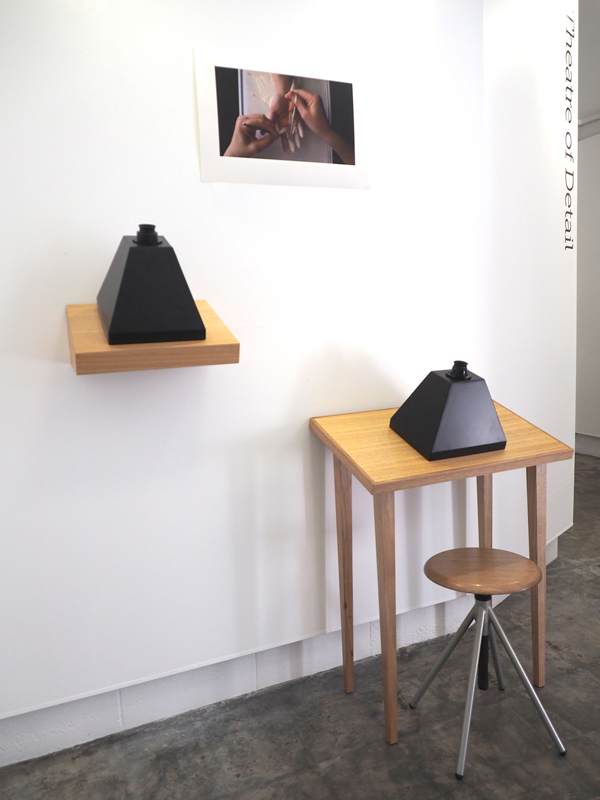
Catherine Truman’s contribution to The Theatre of Detail looks like a conundrum. Her small sculptural installations in the series In Preparation for Seeing appear distant from jewelry. Two gloves, one white and translucent, one black and opaque, are each accompanied by evidence of scientific processes, such as tweezers and the beautiful glass vessels scientists use in the laboratory. Truman’s real subject is the close similarity between artistic and scientific ways of looking: intently, with curiosity, and in detail. Here this looking is staged through her fascination with microscopy. The two gloves refer to principal forms of microscopy—the work with the white glove, In Preparation for Seeing: Cell Culture Glove, is inspired by bright-field microscopy, and its associated hand skills, often used for cell culturing. With this lovely glove, we see right through the applied (magnifying) glass beads on the surface to the woven cotton below. In Preparation for Seeing: SEM Glove, with the black glove, relates to confocal scanning electron microscopy, which uses lasers and looks at the topography of its subjects using 4-D scanning. Here, recalling the exquisite density of these kinds of scanning, the emphasis is on the bubbling surface of the black glass beads atop the dyed black glove.
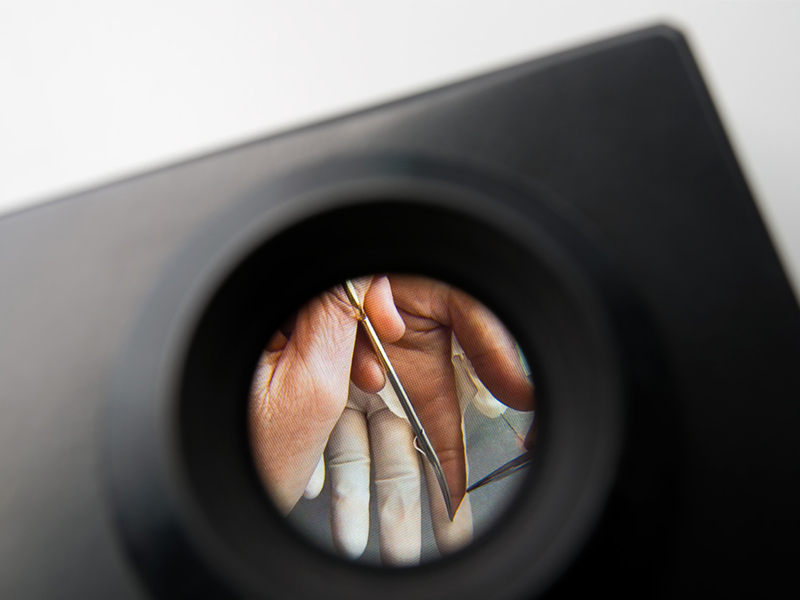
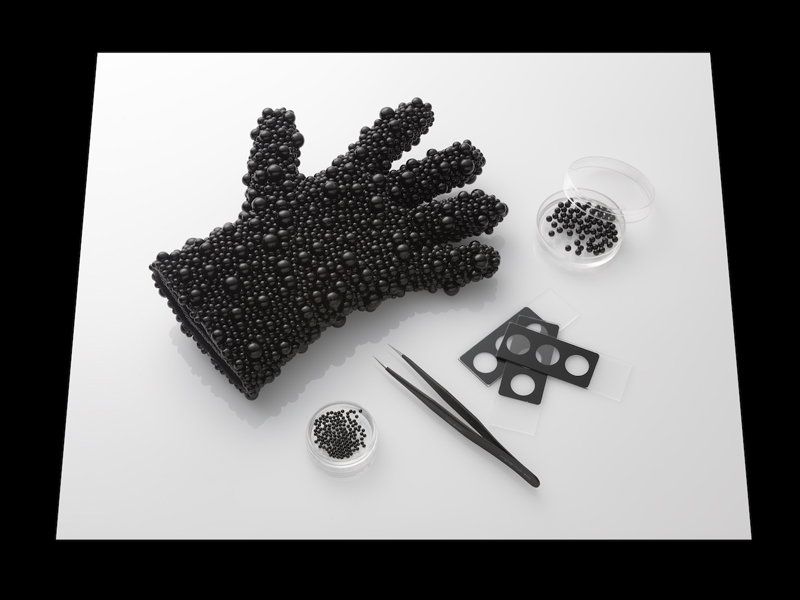
So we have white and black, light and dark. But with the pair of gloves we also have vision and touch, seeing necessarily coupled with making, with the jeweler’s hand. It’s as if touching is seeing with the hands. And that implication informs the two Glove Dissection videos Truman shows on custom-built viewfinders housing iPad minis, with magnifying eyepieces that let us see the hands at exact 1:1 scale. These devices compel solo viewing, extreme intimacy, and reveal the extraordinary care with which Truman’s long-time scientific colleague Pat Vilimas scissors a fine latex laboratory glove from the jeweler’s immobile hand. One video shows the glove being cut away, as if Truman’s hand is being flayed; viewers hold their breath as the hand is exposed to danger. The other video shows the glove closing up, a reversal that in its surgical exactitude summons the miracle of healing. (Above the two viewers, a still photograph showed the procedure at the exact halfway point.) In the background of the videos, a constant low-level hum, rather menacing, heightens the mood of tense expectation. Truman explained, in a talk given at the exhibition, that this was noise from a nearby cryostat room for preparing specimens. For many years she has been an artist-in-residence at science faculties in Adelaide’s universities. The artist, like the scientist, pursues research where it takes her.
Evidently, there is nothing like a house style in the three projects comprising The Theatre of Detail. As Jess Dare said to me recently, “… it’s about finding one’s own voice in one’s work—that is the emphasis …”[2] These three distinct bodies of works are strongly focused around each jewelers’ current research. What GSW does have is something like a set of house rules, evolved over time. The key commitments: mutual respect, independence of thought and vision, curiosity about a wide range of materials, and, above all, a consistent determination to exploration.
The Theatre of Detail is being presented to audiences in three countries during the exhibition tour. I caught up with it at Sydney’s Airspace Projects Gallery, at Square Peg jewelry studios. It will be in Melbourne for Radiant Pavilion, a contemporary jewelry and object fest (September 1–6, 2015), and in 2016 it will be shown at The National in Christchurch, New Zealand, and, finally, at Bangkok’s Atta Gallery. This itinerary encapsulates the networking and community development that Gray Street has fostered over the years, across Australia, in New Zealand, and with jewelers from the USA, who sometimes take up the Workshop’s benches in formal programs, at other times as tenants. This commitment to exchange and dialogue is at the heart of the Workshop’s commitment to constant, self-aware reinvention. I salute it.
The works in this exhibition were priced between $380 AU ($270 US) and $14,200 AU ($9980 US).
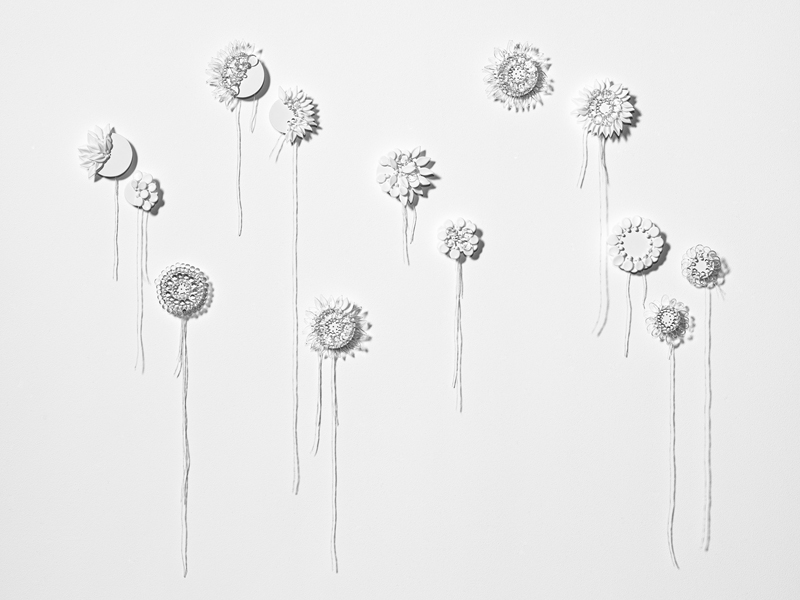
INDEX IMAGE: Sue Lorraine, Models of Light: Light Spot Brooch, 2015, heat-colored steel, polypropylene, stainless steel, largest 80 x 10 x 4 mm, photo: Grant Hancock
[1] Sue Lorraine speaking at the exhibition in Sydney, 13 July 2015
[2]Telephone conversation with Jess Dare, 11 August 2015




